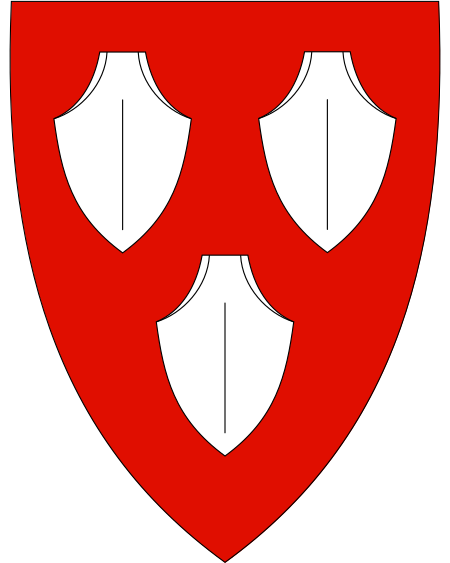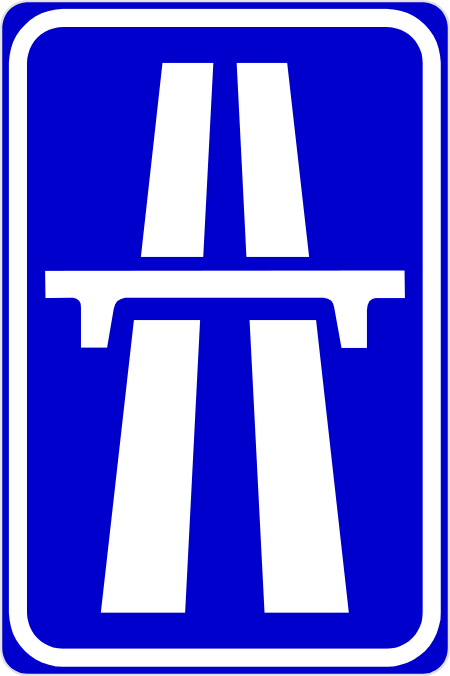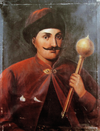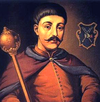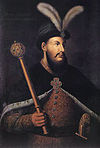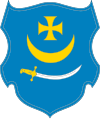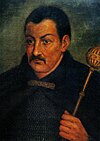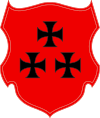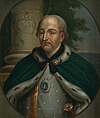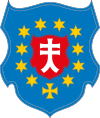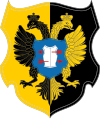| Ruler |
Born |
Reign |
Ruling part |
Consort |
Death |
Notes
|
Rurik I
(Рюрик)
Old Norse: Rørik
|

|
Unknown
|
862–879
|
Kievan Rus'
(at Novgorod)
|
Unknown
at least one son
|
879
|
Ruled as Prince of Novgorod. Founder of the family.
|
Oleg the Seer
(Олег Віщий)
Old Norse: Helgi[5]
|
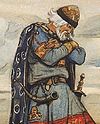
|
Unknown
|
879–912
|
Kievan Rus'
|
Unknown
|
912
|
Varangian kniaz of Holmgård (Novgorod) and Kønugård (Kiev). His relationship with the family is unknown. He was probably a regent, in name of Igor, son of Rurik. Oleg extended his rule over the Derevlianians, Siverianians, Radmichians and Polianians. Began campaigns against the Khazars. Proclaimed himself Prince.
|
Igor I the Old
Igor Rurikovich
(Ігор Старий[6])
Old Norse: Ingvar Röreksson
|
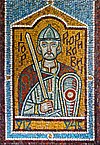
|
c.878
Son of Rurik
|
912–945
|
Kievan Rus'
|
901 or 902
at least one son
|
945
Iskorosten
aged 66–67
|
|
Saint Olga of Kiev
(Свята Ольга)
Old Norse: Helga
|

|
c.890
Pskov
|
945–962
|
Kievan Rus'
|
11 July 969
Kiev
aged 78–79
|
Regent on behalf of her minor son, she was baptized by Emperor Constantine VII but failed to bring Christianity to Kiev.
|
Sviatoslav I the Brave
Sviatoslav Igorevich
(Святосла́в Хоро́брий)
Old Norse: Sveinald Ingvarsson[7]
|

|
c.942
possibly Kiev
Son of Igor I the Old and Saint Olga of Kiev
|
962 – March 972
|
Kievan Rus'
|
Predslava
c.954
two sons
Malusha/Malfrida[8][9]
c.958
at least one son
|
March 972
Khortytsia
aged 29–30
|
The first true ruler of Rus' who destroyed the Khazar Khaganate and united all of the Rus' principalities under the Kiev throne.
|
Yaropolk I
Yaropolk Sviatoslavich
(Яропо́лк Святосла́вич)
Old Norse: Iaropolk Sveinaldsson
|

|
c.950
Son of Sviatoslav I the Brave and Predslava
|
March 972 – 980
|
Kievan Rus'
|
A Greek nun
at least one son
|
980
Fort of Roden, near Kaniv
aged 29–30
|
Supposedly was baptised into Catholicism, and then was murdered by two Varangians.
|
Vladimir I the Great
Vladimir Basil Sviatoslavich
(Володимир Великий/Володимѣръ Свѧтославичь)
Old Norse: Valdamarr Sveinaldsson
|

|
c.958
Budiatychi
Son of Sviatoslav I and Malusha/Malfrida
|
980 – 15 July 1015
|
Kievan Rus'
|
Olava/Allogia
c.977
at least one son
A Greek nun
(widow of his brother)
c.980
at least one son
Rogneda of Polotsk
c.978
(possibly in bigamy)
eight children
Adela (of Bulgaria?)
at least two children (maximum four)
Malfrida (of Bohemia?)
Before 1000
two children
Anna Porphyrogenita of Byzantium
988
Cherson
three children
Regelindis (?) of Saxony (granddaughter of Otto I, Holy Roman Emperor)
After 1011
one or two daughters
Unknown
two children
|
15 July 1015
Berestove
(now part of Kiev)
aged 57–58
|
His early rule is characterized by a staunch pagan reaction but in 988 he was baptized into Orthodoxy and successfully converted Kievan Rus' to Christianity.
|
Sviatopolk I the Accursed
Sviatopolk Yaropolkovich
(Святополк Окаянний)
Old Norse: Sveinpolk Iaropolksson
|

|
c.980
Kiev
Son of Sviatoslav I and Predslava
|
15 July 1015 – 1019
|
Kievan Rus'
|
Unknown name
(daughter of Bolesław I of Poland)
no children
|
1019
Brest
aged 38–39
|
|
Yaroslav I the Wise
Yaroslav George Vladimirovich
(Яросла́в Му́дрий)
Old Norse: Jarizleifr Valdamarrsson[10]
|

|
c.978
Third son of Vladimir I the Great and Rogneda of Polotsk
|
1019 – 20 February 1054
|
Kievan Rus'
|
Ingigerda of Sweden
1019
Novgorod
eight or nine children
|
20 February 1054
Vyshhorod
aged 75–76
|
Prince of Rostov, Prince of Novgorod, and Grand Prince of Kiev; during his reign Kievan Rus' reached the pinnacle of its power.
|
Iziaslav I
Iziaslav Demetrius Yaroslavich
(Ізяслав Ярославич)
Old Norse: Izjasleifr(?) Jarizleifsson
|
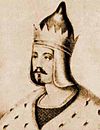
|
c.1024
Second son of Yaroslav I and Ingigerda of Sweden
|
20 February 1054 – 14 September 1068
April 1069 – 22 May 1073
15 July 1076 – 3 October 1078
|
Kievan Rus'
|
Gertrude of Poland
1043
three children
|
3 October 1078
Nizhyn
aged 53–54
|
Reigned three times, threatened by the power of his relatives Vseslav of Polotsk (1068–69) and Sviatoslav II of Kiev (1073–76). First ruler titled King of Rus' , as Pope Gregory VII sent him a crown from Rome in 1075.
|
Vseslav the Seer
Vseslav Basil Bryacheslavich
(Всеслав Брячиславич)
|

|
c.1039
Polotsk
Son of Bryachislav of Polotsk
|
14 September 1068 – April 1069
|
Kievan Rus'
|
Unknown
six children
|
24 April 1101
Polotsk
aged 61–62
|
A brief ruler during Iziaslav's official reign. Also Prince of Polotsk.
|
Sviatoslav II
Sviatoslav Nicholas Yaroslavich
(Святослав Ярославич)
Old Norse: Sveinald Jarizleifsson
|
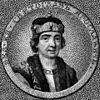
|
c.1027
Kiev
Third son of Yaroslav I and Ingigerda of Sweden
|
22 May 1073 – 15 July 1076
|
Kievan Rus'
|
Cecilia of Dithmarschen [citation needed]
Between 1043 and 1047
five children
Oda of Stade (Nordmark)
c.1065
one son
|
27 December 1076
Kiev
aged 48–49
|
A brief ruler during his brother Iziaslav's official reign.
|
Vsevolod I
Vsevolod Andrew Yaroslavich
(Всеволод Ярославич)
Old Norse: Vissivald Jarizleifsson
|
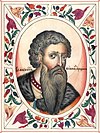
|
c.1030
Fourth son of Yaroslav I the Wise and Ingigerda of Sweden
|
3 October 1078 – 13 April 1093
|
Kievan Rus'
|
Anastasia of Byzantium
c.1053
two children
Anna of the Kipchaks
c.1070
four children
|
13 April 1093
Vyshhorod
aged 62–63
|
Usurped the throne from his nephew, Yaropolk Iziaslavich.
|
Saint Yaropolk Izyaslavich
Yaropolk Peter Iziaslavich
(Ярополк Ізяславич)
Old Norse: Iaropolk Izjasleifsson (?)
|
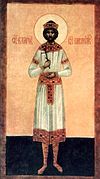
|
c.1043
First son of Iziaslav I and Gertrude of Poland
|
3 October 1078 – 22 November 1087
|
Kievan Rus'
(in opposition)
|
Kunigunde of Meissen
c.1071
four children
|
22 November 1087
Zvenyhorod
aged 62–63
|
As hereditary King of Rus (title assumed until his death), was a legitimate contestant for the throne, usurped by his uncle.
|
Sviatopolk II
Sviatopolk Michael Iziaslavich
(Всеволод Ярославич)
Old Norse: Sveinpolk Izjasleifsson (?)
|
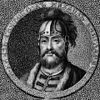
|
8 November 1050
Second son of Iziaslav I and Gertrude of Poland
|
13 April 1093 – 26 April 1113
|
Kievan Rus'
|
Unknown name
(daughter of Spytihněv II of Bohemia)[11]
c.1085
three children
Olenna of the Kipchaks
c.1094
four children
|
26 April 1113
Vyshhorod
aged 62
|
Recovered the throne of his father from his uncle. However, his descendants lost their rights to the Kievan throne. After the division of the territory made in the Council of Liubech of 1097, Kievan Rus' gradually lost its importance, and from 1132 changed name to Kiev.
|
| After the Council of Liubech in 1097 Kievan Rus' entered a feudal period and was divided into principalities ruled by the Rurikid family princes who were in a constant power struggle with each other. Major principalities were: Galicia-Volhynia, Kiev, Chernihiv, and Pereyaslavl. In the period of 1240–1362, the three latter ones were forced to accept the Golden Horde overlordship. See List of early East Slavic states
|
| David Sviatoslavich
|

|
1050
Third son of Sviatoslav II and Cecilia of Dithmarschen
|
1097 – 1 August 1123
|
Chernihiv
|
Teodosia
five children
|
1 August 1123
aged 72–73
|
|
| David Igorevich
|

|
1055
Son of Igor Yaroslavich
|
1097–1099
|
Volhynia
|
Unknown
three children
|
25 May 1112
Dorogobuzh
aged 56–57
|
Grandson of Yaroslav I.
|
| Volodar Rostislavych |

|
c.1060?
First son of Rostislav Vladimirovich of Tmutarakan and Helena of Hungary
|
1097 – 19 March 1124
|
Halych
(at Zvenigorod and Peremyshl)
|
? of Pomerania
four children
|
19 March 1124
aged 63–64?
|
Holders of the region since 1092, since 1097 had fuller control over the principality.
|
| Vasilko Rostislavich |

|
c.1066
Second son of Rostislav Vladimirovich of Tmutarakan and Helena of Hungary
|
1097 – 28 February 1124
|
Halych
(at Terebovlia)
|
Unknown
three children
|
28 February 1124
aged 57–58?
|
Vladimir II Monomakh
Vladimir Basil Vsevolodovich
(Володимир Мономах)
Old Norse: Valdamarr Vissivaldsson
|

|
1053
Son of Vsevolod I and Anastasia of Byzantium
|
1097 – 26 April 1113
|
Pereyaslavl
|
Gytha of Wessex
c.1074
five or six children
Euphemia of Byzantium
c.1100
six or seven children
Unknown name
(daughter of Aepa Ocenevich, Khan in Cumania)
After 1107
no known children
|
19 May 1125
Kiev
aged 71–72
|
Ruled against his relative Sviatopolk II until his own accession to the throne in 1113. He is considered to be the last ruler of the united Kievan Rus'.
|
| 26 April 1113 – 19 May 1125
|
Kievan Rus'
|
| Mstislav Sviatopolkovich
|

|
?
Illegitimate son of Sviatopolk II
|
1099 – 12 June 1099
|
Volhynia
|
Unknown
|
12 June 1099
Volodymyr
|
|
| Yaroslav Sviatopolkovich
|

|
c. 1070
Son of Sviatopolk II and ? of Bohemia
|
12 June 1099 – 1118
|
Volhynia
|
Unknown
(daughter of Ladislaus I of Hungary)
c.1091
Judith-Maria of Poland
c.1106
Unknown
(daughter of Mstislav I of Kiev)
c.1112
three/four children in total
|
May 1124
aged 53–54
|
Retired in 1118.
|
| Sviatoslav Vladimirovich
|

|
1079
Third son of Vladimir II and Gytha of Wessex
|
26 April 1113 – 6 March 1114
|
Pereyaslavl
|
Unmarried
|
6 March 1114
Pereyaslavl
aged 34–35
|
Son of Vladimir II Monomakh.
|
| Roman Vladimirovich
|

|
1081
Fourth son of Vladimir II and Gytha of Wessex
|
1118 – 6 January 1119
|
Volhynia
|
? Volodarevna of Peremyshl
no children
|
6 January 1119
Volodymyr
aged 37–38
|
|
| Constantine Sviatoslavich the Blessed[12]
|
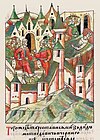
|
1070
First son of Sviatoslav II and Oda of Stade
|
1 August 1123 – 1127
|
Chernihiv
|
Unknown
three children
|
1129
aged 58–59
|
|
| Igor Vasilkovich
|

|
c.1100?
First son of Vasilko Rostislavich
|
28 February 1124 – 1141
|
Halych
(at Terebovlia)
|
Anna Vsevolodovna of Chernihiv
no children
|
1141
Halych
aged 40–41?
|
After their deaths, their cousin Vladimir reunited Terebovlia with Peremyshl and Zvenigorod.
|
| Rostislav Vasilkovich |

|
c.1100?
Second son of Vasilko Rostislavich
|
Unknown
|
c.1141
aged 40–41?
|
| Rostislav Volodarevich |

|
c.1100
First son of Volodar Rostislavich and ? of Pomerania
|
19 March 1124 – 1129
|
Halych
(at Peremyshl)
|
? of Pomerania
four children
|
1129
aged 28–29?
|
Children of Volodar, divided their principalities, but Vladimir ended up reuniting his family's patrimony, forming in 1141 the Principality of Halych.
|
| Vladimir Volodarevich
|

|
1104br>Second son of Volodar Rostislavich and ? of Pomerania
|
19 March 1124 – 1153
|
Halych
(at Zvenigorod; in Peremyshl since 1129, and Terebovlia since 1141)
|
Sophia of Hungary
c.1117
four children
|
1153
aged 48–49
|
Mstislav I the Great
Mstislav Theodore Vladimirovich
(Мстислав Великий)
Old Norse: Haraldr Valdamarrsson
|

|
1 June 1076
Turov
First son of Vladimir II and Gytha of Wessex
|
19 May 1125 – 14 April 1132
|
Kievan Rus'
|
Christina of Sweden
1095
ten children
Liubava Dmitrievna Zavidich
1122
two children
|
14 April 1132
Kiev
aged 55
|
After his reign Kievan Rus' fell into recession starting a rapid decline: the Rus' became reduced to Kiev.
|
| Yaropolk II
|
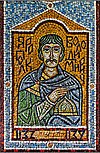
|
1082
Fifth son of Vladimir II and Gytha of Wessex
|
1114 – 14 April 1132
|
Pereyaslavl
|
Helena of Ossetia
1116
one child
|
18 February 1139
aged 56–57
|
|
| 14 April 1132 – 18 February 1139
|
Kiev
|
Vsevolod Mstislavich
Vsevolod David Mstislavich
|
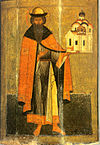
|
1103
Novgorod
Second son of Mstislav I and Christina of Sweden
|
14 April 1132 – 1132
|
Pereyaslavl
|
Anna
before 1125
four children
|
11 February 1138
Pskov
aged 34–35
|
Also prince in Novgorod (1117–32, 1132–36) and Vyshgorod (1136)
|
| Viacheslav I
|

|
1083
Chernihiv
Sixth son of Vladimir II and Gytha of Wessex
|
1133–1134
|
Pereyaslavl
|
Unknown
before 1139
one child
|
2 February 1154
Kiev
aged 70–71
|
Deposed.
|
| 18 February – 4 March 1139
|
Kiev
|
| Andrey Vladimirovich the Good
|

|
11 July 1102
Pereyaslavl
Second son of Vladimir II and Euphemia of Byzantium or ? of the Kipchaks
|
6 January 1119 – 1135
|
Volhynia
|
Unknown
(daughter of Tugor-khan of Polotsk)
c.1117
two children
|
22 January 1141
Pereyaslavl
aged 38
|
|
| 1135 – 22 January 1141
|
Pereyaslavl
|
Vsevolod II
Vsevolod Kirill Olegovich
|

|
1094
First son of Oleg Sviatoslavich and ? of Cumania
|
1127 – 4 March 1139
|
Chernihiv
|
Maria Mstislavna of Kiev
1116
one child
|
1 August 1146
Vyshgorod
aged 51–52
|
Grandson of Sviatoslav II, married Maria, sister of Mstislav I, Yaropolk II and Viacheslav I.
|
| 4 March 1139 – 1 August 1146
|
Kiev
|
| Vladimir Davidovich |
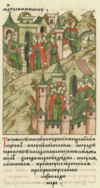
|
c.1110?
First son of David Sviatoslavich and Teodosia
|
4 March 1139 – 12 May 1151
|
Chernihiv
|
? Vsevolodovna of Grodno
1144
one child
|
12 May 1151
aged c.40–41?
|
|
| Saint Igor II |

|
1096
Second son of Oleg Sviatoslavich and ? of Cumania
|
2 – 12 August 1146
|
Kiev
|
Unmarried
|
19 September 1147
aged 50–51 |
Deposed.
|
| Iziaslav II
|

|
1096[13]
Novgorod
First son of Mstislav I and Christina of Sweden
|
1132–1133
1141 – 12 August 1146
|
Pereyaslavl
|
Agnes of Hohenstaufen
before 1151
five children
Rusudan of Georgia[13]
1154
no children
|
13 November 1154[13]
Kiev
aged 57–58
|
|
1135–1141
1146–1151
|
Volhynia
|
12 August 1146[14] – 1149
1151 – 13 November 1154
|
Kiev
|
| Yuri I the Long-Armed
|

|
1099
Pereyaslavl
Second son of Vladimir II and Euphemia of Byzantium or ? of the Kipchaks
|
1132
1134–1135
|
Pereyaslavl
|
Two wives
fifteen children
|
15 May 1157
Kiev
aged 58–59
|
|
1149–1151
1155 – 15 May 1157
|
Kiev
|
| Sviatopolk Mstislavich |

|
1114
Fourth son of Mstislav I and Christina of Sweden
|
1151 – 20 February 1154
|
Volhynia
|
Euphemia of Olomouc[15]
1143 or 1144
no children
|
20 February 1154 |
|
| Iziaslav III
|

|
1115
Second son of David Sviatoslavich and Teodosia
|
1151 – 1154
1155-15 May 1157
|
Chernihiv
|
Unknown
one child
|
6 March 1161
Kiev
aged 45–46
|
|
13 November 1154–1155
15 May 1157 – 12 April 1159
12 February 1161 – 6 March 1161
|
Kiev
|
| Rostislav I
|
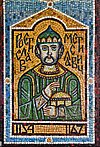
|
1110
Kiev
Third son of Mstislav I and Christina of Sweden
|
8 – 15 December 1154
12 April 1159 – 12 February 1161
6 March 1161 – 14 March 1167
|
Kiev
|
Unknown
eight children
|
14 March 1167
aged 56–57
|
|
| Yaroslav Vladimirovich the Eight-Minded
|

|
1130
Son of Vladimir Volodarevich and Sophia of Hungary
|
1153 – 1 October 1187
|
Halych
|
Olga Yurievna of Vladimir-Suzdal
four children
Anastasia
one child
|
1 October 1187
Halych
aged 56–57 |
|
| Sviatoslav Olegovich |

|
1106/07
Third son of Oleg Sviatoslavich and ? of Cumania
|
1154–1155
15 May 1157 – 14 February 1164
|
Chernihiv
|
? of Cumania
two children
Ekaterina Petrovna of Novgorod
four children
|
14 February 1164
aged 58–60 |
|
| Mstislav II the Brave
|

|
1125
First son of Iziaslav II and Agnes of Hohenstaufen
|
12 August 1146 – 1149
6 April 1151 – 1154
|
Pereyaslavl
|
Agnes of Poland
1151
three children
|
19 August 1170
Veliky Novgorod
aged 44–45
|
|
| 1157 – 19 August 1170
|
Volhynia
|
19 May 1167 – 12 March 1169
March 1170 – 19 August 1170
|
Kiev
|
| Rostislav Yurievich |

|
c.1120?
First son of Yuri I
|
1149 – 6 April 1151
|
Pereyaslavl
|
Unknown
before 1151
three children
|
6 April 1151
Pereyaslavl
aged |
Son of Yuri I.
|
| Gleb
|
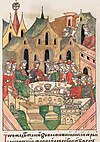
|
1125
Fourth son of Yuri I
|
1154–1169
|
Pereyaslavl
|
? Iziaslavna of Chernihiv
1154
three children
|
20 January 1171
Kiev
aged 45–46
|
|
1169
1170 – 20 January 1171
|
Kiev
|
| Vladimir III
|

|
1132
First son of Mstislav I and Liubava Dmitrievna Zavidich
|
1154–1157
|
Volhynia
|
Unknown
(daughter of Grand Prince Beloš Vukanović of Serbia)
1150
four children
|
30 May 1171
Kiev
aged 38–39
|
|
| 17 February 1171 – 30 May 1171
|
Kiev
|
| Vladimir Glebovich
|
|
1157
Son of Gleb and ? Iziaslavna of Chernihiv
|
1169 – 18 April 1187
|
Pereyaslavl
|
Unknown
1180
no children
|
18 April 1187
Pereyaslavl
aged 29–30 |
|
| Sviatoslav Mstislavich
|

|
?
Third son of Mstislav II and Agnes of Poland
|
19 August 1170 – 1173
|
Volhynia
|
Unknown
|
1173 or 1193 |
|
| Michael I |

|
1145
Suzdal
Tenth son of Yuri I
|
12 June – 1 July 1171
|
Kiev
|
Fevronia
before 1176
two children
|
20 June 1176
Gorodets
aged 30–31 |
Also Grand Duke of Vladimir (1175–1176).
|
| Roman I |
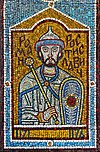
|
c.1130
Smolensk
First son of Rostislav I
|
1 July 1171–1173
1175–1177
|
Kiev
|
Maria Sviatoslavna of Chernihiv
9 January 1149
three children
|
14 June 1180
Smolensk
aged 49–50 |
|
| Vsevolod III the Big Nest
|

|
19 October 1154
Dmitrov
Eleventh son of Yuri I
|
1173
|
Kiev
|
Maria Shvarnovna
fourteen children
Liubava Vasilkovna of Vitebsk
1209
no children
|
15 April 1212
Vladimir
aged 57 |
Also Grand Duke of Vladimir (1176–1212).
|
| Rurik II
|

|
c.1137
Second son of Rostislav I
|
1173
1180–1182
1194–1202
1203–1204
1206
1207–1210
|
Kiev
|
Unknown
1163
Anna Yurievna of Turov[16]
before 1176
six children
|
19 April 1214
Chernihiv
aged 76–77
|
Also Prince of Ovruch (1167–1194), city which was probably his original seat.
|
| 1212 – 19 April 1214[17]
|
Chernihiv
|
| Sviatoslav III
|

|
1123
Chernihiv
First son of Vsevolod II and Maria Mstislavna of Kiev
|
1141–1146
|
Volhynia
|
Maria Vasilkovna of Polotsk
1143
eight children
|
25 July 1194
Brest
aged 70–71
|
|
| 14 February 1164 – 1180
|
Chernihiv
|
1173–1174
1177–1180
1182 – 25 July 1194
|
Kiev
|
| Yaroslav II |

|
1132
Second son of Iziaslav II and Agnes of Hohenstaufen
|
1174–1175
1180
|
Kiev
|
Richeza of Bohemia
1149
four children
|
1180
Lutsk
aged 47–48 |
|
| Yaroslav Vsevolodovich |

|
1139
Chernihiv
Second son of Vsevolod II and Maria Mstislavna of Kiev
|
1180–1198
|
Chernihiv
|
Irene[18][19]
before 1171
three children
|
1198
aged 58–59
|
|
| Yaroslav Mstislavich the Red |

|
c.1160
Son of Mstislav Yurevich of Vladimir-Suzdal and ? of Cumania
|
18 April 1187 – 1199
|
Pereyaslavl
|
Unmarried
|
1199
aged 38–39 |
Grandson of Yuri I.
|
| Oleg Yaroslavich Nastasich |

|
?
Son of Yaroslav Vladimirovich and Anastasia
|
1 October 1187 – 1187
|
Halych
|
Unknown
|
1187/8
Halych |
|
| Vladimir Yaroslavich |

|
1151
Son of Yaroslav Vladimirovich and Olga Yurievna of Vladimir-Suzdal
|
1187–1188
1189–1199
|
Halych
|
Boleslava
c.1166
one child
|
1199
Halych
aged 46–47 |
After his death, Halych reunited with Volhynia.
|
Igor Sviatoslavich the Brave
Igor Yuri Sviatoslavich
(Ігор Святославич)
Old Norse:Ingvar Sveinaldsson |

|
2 April 1151
Novhorod-Siverskyi
First son of Sviatoslav Olegovich and Ekaterina Petrovna of Novgorod
|
1198 – 29 December 1202
|
Chernihiv
|
Euphrosyne Yaroslavna of Halych[20]
before 1170
five children
|
29 December 1202
Chernihiv
aged 51
|
|
| Ingvar |
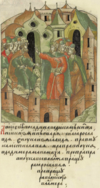
|
1152
Son of Yaroslav II and Richeza of Bohemia
|
1202–1203
1212–1214
|
Kiev
|
Unknown
five children
|
1220
aged 68–69
|
|
Roman I the Great
(Роман Мстиславич)
|
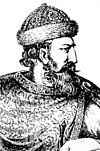
|
1152
First son of Mstislav II and Agnes of Poland
|
1188–1189
|
Halych
|
Predslava Rurikovna of Ovruch
1170 or 1180
two children
Anna-Euphrosyne Angelina
c.1197
two children
|
19 June 1205
Zawichost
aged 52–53
|
Son-in-law of Rurik II. His reign marked the rise of Galicia-Volhynia as a Kievan Rus' successor state. Galicia-Volhynia was a Ruthenian
[21][22][23][24][25][26] state in Galicia and Volhynia.
|
1173–1188
1188–1198
|
Volhynia
|
1198 – 19 June 1205
(as Prince[27])
|
Volhynia & Halych, then Galicia-Volhynia
|
| February 1204 – 19 June 1205
|
Kiev
|
| Vsevolod Mstislavich
|

|
c.1160
Fourth son of Mstislav II and Agnes of Poland
|
1188
|
Volhynia
|
Unknown
three children
|
April 1195
Belzaged 34–35 |
|
| Rostislav II |

|
13 April 1172
First son of Rurik II and Anna Yurievna of Turov
|
February 1204 – 19 June 1205
|
Kiev
|
Verchoslava Vsevolodovna of Vladimir-Suzdal
15 June 1187
one child
|
3 March 1218
aged 45 |
Son-in-law of Vsevolod III. Ruled with Roman the Great, his brother-in-law.
|
| Oleg Sviatoslavich
|
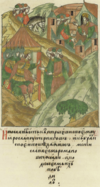
|
1147
Son of Sviatoslav Olegovich and ? of Cumania
|
29 December 1202 – 1204
|
Chernihiv
|
Euphrosyne Yurievna of Yelets
1176
two children
|
1204
Chernihiv
aged 56–57
|
|
| Vsevolod IV the Red
|

|
c.1150
Second son of Sviatoslav III and Maria Vasilkovna of Polotsk
|
1204 – 1212
19 April 1214 – August 1215
|
Chernihiv
|
Maria Anastasia of Poland
14 October or 24 December 1178[citation needed] or 14 November 1179
four children
|
August 1215
Chernihiv
aged 64–65
|
|
1206–1207
1210 – August 1215
|
Kiev
|
| Regency of Anna-Euphrosyne Angelina (1205–1214)
|
Held many titles since early childhood culminating with the crowning by a papal legate, archbishop Opizo, in Dorohychyn in 1253, King of Rus'. the title became hereditary in his domains.
|
Daniel
(Данило Романович)
|

|
1201
Halych
Son of Roman the Great and Anna-Euphrosyne Angelina
|
19 June 1205 – 1264
|
Galicia-Volhynia
|
Anna Mstislavna of Novgorod
c.1220
eight children
? of Lithuania
(niece of Mindaugas)
c.1250
no children
|
1264
Kholm
aged 62–63
|
Coloman of Galicia
(Kálmán)
|

|
1208
Second son of Andrew II of Hungary and Gertrude of Merania
|
1215–1221
|
Galicia-Volhynia
(in opposition)
|
Salomea of Poland
1215
no children
|
May 1241
Čazma
aged 32–33
|
Hungarian prince Kálmán, Prince of Halych (1214–15), became the first anointed and crowned and King of Galicia-Volhynia (rex Galiciae et Lodomeriae) in 1215. Despite that, the first nominal king of Galicia was Andrew II of Hungary (r.1188–90).[28][29][30] Also Duke of Slavonia from 1226.
|
| Mstislav III the Old
|
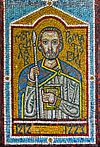
|
1156
Smolensk
Second son of Roman I and Maria Sviatoslavna of Chernihiv
|
19 April 1214 – 2 June 1223
|
Kiev
|
Unknown
1116
seven children
|
2 June 1223
Kalchyk River
aged 66–67 |
|
| Gleb Sviatoslavich |

|
1168
Fourth son of Sviatoslav III and Maria Vasilkovna of Polotsk
|
August 1215 – 1217
|
Chernihiv
|
Anastasia Rurikovna of Ovruch
1183
three children
|
1220[18]
aged 51–52 |
Son-in-law of Rurik II.
|
| Mstislav Sviatoslavich
|

|
c.1170
Fifth son of Sviatoslav III and Maria Vasilkovna of Polotsk
|
1217 – 31 May 1223
|
Chernihiv
|
Yasynya-Marfa Shvarnovna
1183
four children
|
31 May 1223
Kalchyk River
aged 66–67
|
Brother-in-law of Vsevolod III.
|
| Vladimir IV
|

|
September–December 1187
Second son of Rurik II and Anna Yurievna of Turov
|
1206–1213
|
Pereyaslavl
|
Unknown
before 1239
four children
|
3 March 1239
Ovruch
aged 51
|
|
2 June 1223 – 1235
1236 – 3 March 1239
|
Kiev
|
| Vladimir Vsevolodovich |

|
25 October 1193
Sixth son of Vsevolod III and Maria Shvarnovna
|
1213–1215[31]
|
Pereyaslavl
|
unknown
before 1239
four children
|
6 December 1227
Starodub-on-the-Klyazma
aged 34
|
After his death the Principality was integrated on the Principality of Yaroslavl and then on the Principality of Vladimir.
|
| Pereyaslavl was annexed by Yaroslavl, and then by Vladimir-Suzdal. See Russian rulers for later princes.
|
| Iziaslav IV |

|
1186
Son of Mstislav III
|
1235–1236
|
Kiev
|
Agafia
no children
|
1255
aged 68–69
|
|
| Yaroslav III
|

|
8 February 1191
Pereslavl-Zalessky
Fifth son of Vsevolod III and Maria Shvarnovna
|
1199–1206
|
Pereyaslavl
|
Unknown
1205
no children
Rostislava of Novgorod
1214
(annulled 1216)
no children
Teodosia Mstislavna of Ryazan
1218
twelve children
|
30 September 1246
Karakorum
aged 55
|
Also Grand Duke of Vladimir (1238–1246).
|
1236–1238
20 – 30 September 1246
|
Kiev
|
| Saint Michael II
|

|
1179
Kiev
First son of Vsevolod IV and Maria Anastasia of Poland
|
1206
|
Pereyaslavl
|
Helena Daniilovna of Galicia-Volhynia
1210 or 1211[32]
seven children
|
20 September 1246
Sarai
aged 66–67
|
While in negotiations with the Golden Horde, his son Rostislav took briefly Kiev throne in 1239, before being expelled by Daniel of Galicia, who protected Kiev's throne until Michael's return in 1240. However, the city was destroyed in that year. Regained Chernihiv throne in 1243, co-ruling with his cousin Andrey Mstislavich.
|
31 May 1223 – 1234
1243 – 20 September 1246
|
Chernihiv
|
1238–1239
1239 – 20 September 1246
|
Kiev
|
| Mstislav Glebovich |
|
c.1210?
Son of Gleb Sviatoslavich and Anastasia Rurikovna of Ovruch
|
1234–1239
|
Chernihiv
|
Unknown
before 1239
two children
|
1239/40
aged 29–30? |
|
| Rostislav III
|

|
1189
Son of Mstislav III
|
1239
|
Kiev
|
Unknown
five children
|
align="center"c.1240
aged 50–51
|
While Michael II was negotiating with the Golden Horde, Rostislav took Kiev in 1239, but was expelled by Daniel of Galicia, who put Voivode Dmytro to protect Kiev's throne.
|
| Rostislav Mikhailovich
|

|
1219
First son of Michael II and Helena Daniilovna of Galicia-Volhynia
|
1239–1243
|
Chernihiv
|
Anna of Hungary
1243
five children
|
1262
Belgrade
aged 42–43
|
While his father was negotiating with the Golden Horde, Rostislav took Chernihiv in 1239, which then returned to Michael. Rostislav made most of his career out of Rus', competing for the Bulgarian throne, and holding the titles of Duke of Macsó and Ban of Slavonia.
|
| Andrey Mstislavich[33] |
|
?
Son of Mstislav Glebovich
|
1245–1246
|
Chernihiv
|
Unknown
|
1246
|
Co-ruling with Michael II in Chernihiv.
|
| Saint Alexander Nevsky |
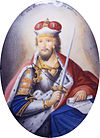
|
13 May 1221
Pereslavl-Zalessky
Second son of Yaroslav III and Teodosia Mstislavna of Ryazan
|
30 September 1246 – 14 November 1263
|
Kiev
|
Praskovia-Alexandra Bryacheslavna of Polotsk
1239
five children
Vassilissa
before 1263
no children
|
14 November 1263
Gorodets
aged 42
|
Also Grand Prince of Vladimir (1252–1263).
|
| Andrey Vsevolodovich |
|
c.1190
Second son of Vsevolod IV and Maria Anastasia of Poland
|
20 September 1246 – 1263
|
Chernihiv
|
Unknown
|
1263
aged 72–73 |
|
| Yaroslav IV |
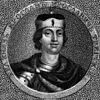
|
1230
Sixth son of Yaroslav III and Teodosia Mstislavna of Ryazan
|
14 November 1263 – 16 September 1271
|
Kiev
|
Natalia
before 1252
two children
Saint Xenia of Tarusa
1265
four children
|
16 September 1271
Tver
aged 40–41 |
Also Grand Prince of Vladimir.
|
| Roman Mikhailovich I the Elder |
|
c.1220
Second son of Michael II and Helena Daniilovna of Galicia-Volhynia
|
1263–1288
|
Chernihiv
|
Anna
four children
|
1288
aged c.67–68 |
|
Leo I
(Лев Дани́лович)
|

|
1228
Second son of Daniel and Anna Mstislavna of Novgorod
|
1264–1301
|
Galicia-Volhynia
|
Constance of Hungary
1246/47
three children
|
1301
Lviv
aged 72–73
|
Moved the capital of Galicia from Kholm to Lviv in 1272. After his death Kiev fell to Lithuania: until at least 1362, were installed Lithuanian governors in Kiev.[34]
|
| 16 September 1271 – 1301
|
Kiev
|
| Kiev annexed to Lithuania
|
| Oleg Romanovich |
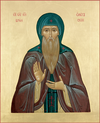
|
c.1245
Second son of Roman Mikhailovich I and Anna
|
1288-1292/1303
|
Chernihiv
|
Unmarried
|
30 September 1307
aged c.61–62 |
Resigned.
|
| Michael Alexandrovich |
|
c.1240
Son of Alexander Romanovich, Prince of Bryansk
|
1292/1303-1307
|
Chernihiv
|
Unknown
one child
|
After 1307
Chernihiv
aged c.60–61 |
Grandson of Roman Mikhailovich I. With his death, the Chernigov line apparently died out; the principality was taken by the Ruriks of Smolensk, princes of Bryansk and descendants of Rostislav I and Roman I.
|
| Chernihiv annexed to the Principality of Bryansk (1307–1401) and then to Lithuania (since 1401)
|
Yuri I
(Ю́рій Льво́вич)
|

|
24 April 1252
Lviv
Son of Leo I and Constance of Hungary
|
1301 – 21 April 1308
|
Galicia-Volhynia
|
Xenia Alexandrovna of Vladimir-Suzdal
1282
one child
Euphemia of Kuyavia
1287
four children
|
21 April 1308
Lviv
aged 55
|
|
Andrey
(Андрій Юрієвич)
|
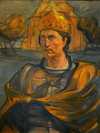
|
c.1290
Lviv
First son of Yuri I and Euphemia of Kuyavia
|
21 April 1308 – May 1323
|
Galicia-Volhynia
|
Unknown
one child
|
May 1323
Berestia
aged c.32–33
|
Ruled jointly, and died also together in battle.
|
Leo II
(Лев Юрійович)
|

|
c.1290
Lviv
Second son of Yuri I and Euphemia of Kuyavia
|
Unknown
|
Maria
(Марія Юріївна)
|
|
c.1290
Lviv
First daughter of Yuri I and Euphemia of Kuyavia
|
May 1323 – 11 January 1341
|
Galicia-Volhynia
(in Halych and Lviv)
|
Trojden I, Duke of Masovia
1310
four children
|
11 January 1341
aged c.50–51
|
Heiresses of the realm, and the true owners of power, Maria and Euphemia (aunt and niece) divided Halych-Volhynia in halves, and ruled them with their respective co-rulers: Maria ruled with her son, and Euphemia with her husband. Their division would also dictate the later Galicia–Volhynia Wars, in which Poland claimed all of the kingdom by having a higher claim than Lithuania. In spite of this, Poland kept only Halych, while Volhynia was annexed to Lithuania.
|
Yuri II Boleslav[35]
(Юрій-Болеслав Тройденович)
|
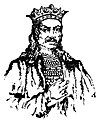
|
1311
Lviv
First son of Trojden I, Duke of Masovia and Maria
|
May 1323 – 7 April 1340
|
Euphemia of Lithuania (uk)
1331
no children
|
7 April 1340
Volodymyraged 28–29
|
Anna-Euphemia
(Ганна-Буча-Євфимія Андрійівна)
|
|
c.1310
Lviv
Daughter of Andrey
|
May 1323 – c.1345?
|
Galicia-Volhynia
(in Volhynia and Lutsk)
|
Liubartas
1321/23
no children
|
1345?
aged c.34–35?
|
Liubartas
(Лю́барт-Дмитро)
|
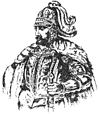
|
1311
Son of Gediminas, Grand Duke of Lithuania and Jaunė
|
Anna-Euphemia
1321/23
no children
Olga Agafiya Konstantinovna of Rostov
1349
four children
|
4 August 1383
aged 71–72
|
| Halych annexed to Poland; Volhynia annexed to Lithuania
|


